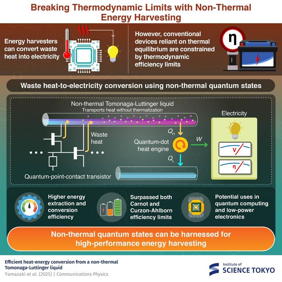Home > Press > Breaking barriers in energy-harvesting using quantum physics: Researchers find a way to overcome conventional thermodynamic limits when converting waste heat into electricity
 |
| This infographic depicts a simplified diagram of the novel energy-harvesting technique using the TL liquid. Implementation of this strategy in practice could help in the conversion of waste heat generated from electronic devices into usable power.
Credit Institute of Science Tokyo |
Abstract:
Harnessing quantum states that avoid thermalization enables energy harvesters to surpass traditional thermodynamic limits such as Carnot efficiency, report researchers from Japan. The team developed a new approach using a non-thermal Tomonaga-Luttinger liquid to convert waste heat into electricity with higher efficiency than conventional approaches. These findings pave the way for more sustainable low-power electronics and quantum computing.
Breaking barriers in energy-harvesting using quantum physics: Researchers find a way to overcome conventional thermodynamic limits when converting waste heat into electricity
Tokyo, Japan | Posted on October 3rd, 2025
i from NTT Basic Research Laboratories, Japan, has found a way to bypass this barrier. In their paper published in Communications Physics on September 30, 2025, the team introduced a novel energy-harvesting technique that uses unique quantum states to achieve efficiencies that go beyond the conventional thermodynamic limits.
Instead of relying on traditional thermal states, the researchers harnessed the properties of a non-thermal Tomonaga-Luttinger (TL) liquid. This is a special type of one-dimensional electron system that, due to its quantum nature, does not thermalize. This means that when heat is introduced, the system holds onto its non-thermal, high-energy state rather than spreading the energy out evenly, as happens in a conventional thermal system.
The research team designed an experiment to demonstrate the potential of this concept. They injected waste heat from a quantum point contact transistora device that controls electron flowinto a TL liquid. This non-thermal heat was transported several micrometers to a quantum-dot heat engine, which is a microscopic device that converts heat into electricity through quantum effects. The researchers found that this unconventional heat source produced a significantly higher electrical voltage and achieved higher conversion efficiency, performing much better than a conventional, quasi-thermalized heat source. These results encourage us to utilize TL liquids as a non-thermal energy resource for new energy-harvesting designs, says Fujisawa.
Subsequently, the researchers developed a model based on a binary Fermi distribution to provide a description of non-thermal electron states in the proposed system. Using it, they showed that their technique surpasses not only the Carnot efficiency but also the Curzon-Ahlborn efficiency, which describes the efficiency at maximum power output of conventional heat engines.
Overall, this research opens the door to a new generation of energy harvesting, leveraging non-thermal quantum states. Our findings suggest that waste heat from quantum computers and electronic devices can be converted into usable power via high-performance energy harvesting, remarks Fujisawa. With any luck, further efforts in this field will make future technologies more powerful and sustainable.
####
About Institute of Science Tokyo (Science Tokyo)
Institute of Science Tokyo (Science Tokyo) was established on October 1, 2024, following the merger between Tokyo Medical and Dental University (TMDU) and Tokyo Institute of Technology (Tokyo Tech), with the mission of Advancing science and human wellbeing to create value for and with society.
For more information, please click here
Contacts:
Komoda Nami
Institute of Science Tokyo (Science Tokyo)
Copyright © Institute of Science Tokyo (Science Tokyo)
If you have a comment, please Contact us.
Issuers of news releases, not 7th Wave, Inc. or Nanotechnology Now, are solely responsible for the accuracy of the content.
News and information
![]()
Researchers develop molecular qubits that communicate at telecom frequencies October 3rd, 2025
![]()
Next-generation quantum communication October 3rd, 2025
![]()
“Nanoreactor” cage uses visible light for catalytic and ultra-selective cross-cycloadditions October 3rd, 2025
Possible Futures
![]()
Spinel-type sulfide semiconductors to operate the next-generation LEDs and solar cells For solar-cell absorbers and green-LED source October 3rd, 2025
![]()
Researchers tackle the memory bottleneck stalling quantum computing October 3rd, 2025
Quantum Computing
![]()
Researchers develop molecular qubits that communicate at telecom frequencies October 3rd, 2025
![]()
Researchers tackle the memory bottleneck stalling quantum computing October 3rd, 2025
![]()
Japan launches fully domestically produced quantum computer: Expo visitors to experience quantum computing firsthand August 8th, 2025
![]()
Quantum computers simulate fundamental physics: shedding light on the building blocks of nature June 6th, 2025
Discoveries
![]()
Researchers develop molecular qubits that communicate at telecom frequencies October 3rd, 2025
![]()
Next-generation quantum communication October 3rd, 2025
![]()
“Nanoreactor” cage uses visible light for catalytic and ultra-selective cross-cycloadditions October 3rd, 2025
![]()
Researchers tackle the memory bottleneck stalling quantum computing October 3rd, 2025
Announcements
![]()
Rice membrane extracts lithium from brines with greater speed, less waste October 3rd, 2025
![]()
Researchers develop molecular qubits that communicate at telecom frequencies October 3rd, 2025
![]()
Next-generation quantum communication October 3rd, 2025
![]()
“Nanoreactor” cage uses visible light for catalytic and ultra-selective cross-cycloadditions October 3rd, 2025
Interviews/Book Reviews/Essays/Reports/Podcasts/Journals/White papers/Posters
![]()
Spinel-type sulfide semiconductors to operate the next-generation LEDs and solar cells For solar-cell absorbers and green-LED source October 3rd, 2025
![]()
Rice membrane extracts lithium from brines with greater speed, less waste October 3rd, 2025
![]()
Researchers develop molecular qubits that communicate at telecom frequencies October 3rd, 2025
Battery Technology/Capacitors/Generators/Piezoelectrics/Thermoelectrics/Energy storage
![]()
Rice membrane extracts lithium from brines with greater speed, less waste October 3rd, 2025
![]()
Sensors innovations for smart lithium-based batteries: advancements, opportunities, and potential challenges August 8th, 2025
![]()
Deciphering local microstrain-induced optimization of asymmetric Fe single atomic sites for efficient oxygen reduction August 8th, 2025
![]()
Simple algorithm paired with standard imaging tool could predict failure in lithium metal batteries August 8th, 2025










